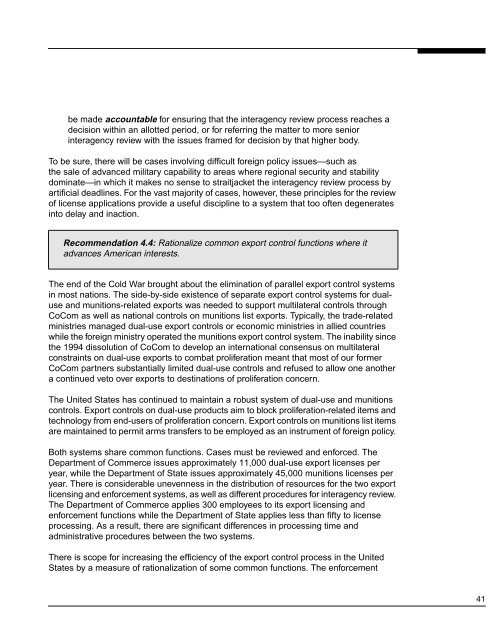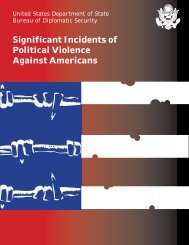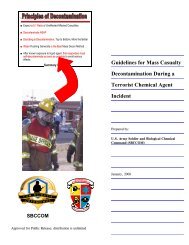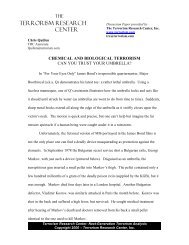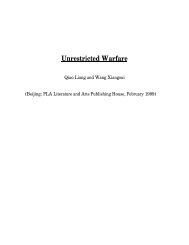Combating Proliferation of Weapons of Mass Destruction
Combating Proliferation of Weapons of Mass Destruction
Combating Proliferation of Weapons of Mass Destruction
You also want an ePaper? Increase the reach of your titles
YUMPU automatically turns print PDFs into web optimized ePapers that Google loves.
e made accountable for ensuring that the interagency review process reaches adecision within an allotted period, or for referring the matter to more seniorinteragency review with the issues framed for decision by that higher body.To be sure, there will be cases involving difficult foreign policy issues—such asthe sale <strong>of</strong> advanced military capability to areas where regional security and stabilitydominate—in which it makes no sense to straitjacket the interagency review process byartificial deadlines. For the vast majority <strong>of</strong> cases, however, these principles for the review<strong>of</strong> license applications provide a useful discipline to a system that too <strong>of</strong>ten degeneratesinto delay and inaction.Recommendation 4.4: Rationalize common export control functions where itadvances American interests.The end <strong>of</strong> the Cold War brought about the elimination <strong>of</strong> parallel export control systemsin most nations. The side-by-side existence <strong>of</strong> separate export control systems for dualuseand munitions-related exports was needed to support multilateral controls throughCoCom as well as national controls on munitions list exports. Typically, the trade-relatedministries managed dual-use export controls or economic ministries in allied countrieswhile the foreign ministry operated the munitions export control system. The inability sincethe 1994 dissolution <strong>of</strong> CoCom to develop an international consensus on multilateralconstraints on dual-use exports to combat proliferation meant that most <strong>of</strong> our formerCoCom partners substantially limited dual-use controls and refused to allow one anothera continued veto over exports to destinations <strong>of</strong> proliferation concern.The United States has continued to maintain a robust system <strong>of</strong> dual-use and munitionscontrols. Export controls on dual-use products aim to block proliferation-related items andtechnology from end-users <strong>of</strong> proliferation concern. Export controls on munitions list itemsare maintained to permit arms transfers to be employed as an instrument <strong>of</strong> foreign policy.Both systems share common functions. Cases must be reviewed and enforced. TheDepartment <strong>of</strong> Commerce issues approximately 11,000 dual-use export licenses peryear, while the Department <strong>of</strong> State issues approximately 45,000 munitions licenses peryear. There is considerable unevenness in the distribution <strong>of</strong> resources for the two exportlicensing and enforcement systems, as well as different procedures for interagency review.The Department <strong>of</strong> Commerce applies 300 employees to its export licensing andenforcement functions while the Department <strong>of</strong> State applies less than fifty to licenseprocessing. As a result, there are significant differences in processing time andadministrative procedures between the two systems.There is scope for increasing the efficiency <strong>of</strong> the export control process in the UnitedStates by a measure <strong>of</strong> rationalization <strong>of</strong> some common functions. The enforcement41


